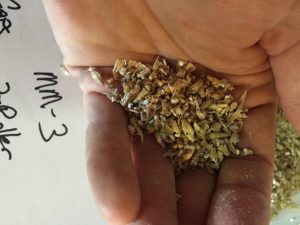A quick note before we begin – we will always tell you when a manufacturer has provided us with goods to test. In this case, Monster Brewing Hardware did not provide Drew the mill. This is his review of his purchase.
It’s funny the little things that conspire to keep you from doing a thing you love. Time, family, work, obligations are all a part of it, but sometimes it’s also just a small pain point that’s enough to prevent you from building up the head of steam to overcome the joyful inertia of sitting on your butt (particularly when it’s hot and there’s A/C inside)

Doesn’t this look more fun than sweating over a brew kettle in the SoCal summer?
In my case, my speed bump was my old mill. I bought a good quality 2 roller mill a number of years ago because it seemed like a natural thing to do. Get bulk grain cheap, mill on demand – fresh beer! I really love having a mill on hand. Makes the brew life a more “on demand” type of thing.
My mill worked like a charm for a decade, but for the last few years, it’s become annoying and terrible. Get milling on some grain, chug along and *screech* – the whole assemble would stop. The roller attached to the drill would keep spinning furiously, but the passive roller would be stuck. I developed a technique of carefully reaching under the mill and helping re-engage the passive roller to crush out another pound.
I tried rehabbing the mill. Taking it apart, brushing and blowing everything out, making sure there was no obvious friction wear. Checking the gap – not too tight, not too loose, etc. But no matter what, every batch became a seemingly Sisyphean struggle – mill vs man – man vs his desire to brew – man vs his desire to say “f this, I’m going to have a beer.” Even at my recent Brew With A Falcon event, the same damn thing happened (after I pre-prepped the mill). I finally decided I had to replace the old girl and put out a call on the webs for everyone’s favorite. Hands down the answer came back – Monster Mill MM-3.
N.B. Astute readers will notice I haven’t said what brand my old mill is. I haven’t because I still believe the old mill is a pretty fine mill and I’d really rather not slag on a company for the performance of a decade old piece of machinery that could probably be rehabbed by someone compentent. (aka – anyone other than me). Plus the old mill has the advantage of being less expensive than the MM-3, so there’s that too.
Last week, the MM-3 I ordered arrived and that naturally meant I had to put it to it’s paces. I assembled the mill and the hopper in a half hour and my first note on the thing – it’s a beast. That is some seriously heavy metal in the gizmo.
 The Mill in Rest
The Mill in Rest
Walking into the garage brewery, I have bins of grain at the ready. Vacuum sealed specialty malts on the left in tubs, base grains in buckets sealed with Gamma lids. (Each bucket holds 25 lbs). I love those lids. Aside from freshness, these methods of sealing have kept my grains rodent free for years. (The colony of feral cats in my neighborhood helps too, just like in Chicago.)

Base Grains (2-Row, Pils, Maris Otter, etc)

Specialty Grains in Tubs (Mythical Flavor Bucket in Lower Left)
To keep the test simple, I grabbed 6 lbs of Great Western 2-Row from the buckets and set about a simple timing test. After all for me, my primary worry was “Can I mill three pounds of grain with as little fuss as possible” Bonus – this also counts as the “cleaning the mill” step to clear off any remaining machining oil.

Weighing the Grain – 3 lbs only,Vasili
Next on the list of things to replace in the brewery – this drill. How it hasn’t killed me yet, I don’t know, but rest assured by the time you read this I will have replaced it! (It’s also a beast)

The Death Drill
First test – let’s fire up the old mill. Remember this is a simple 2-roller mill. One roller driven by the drill, the other by the friction of the grain falling into the gap.

The Old Mill
The Old Mill mostly cooperated today – during it’s run of 3 lbs, it only jammed up and stopped once, necessitating the ole reach under to fix. Total time to mill 3 lbs with the stoppage – 53.4 seconds according to the clock

Old Mill Time
Ok, onto the MM-3 – same test. The MM-3 chewed through the grain like a hungry beast and the only surprise I had was the mill really wants the chuck to be tightened down. Had to stop for a moment and retighten the chuck. I don’t know how well a modern keyless chuck would work and I don’t think you’d want a cordless drill anywhere near this thing. Remember, you have to put enough force into the drive shaft to drive the main roller and two passive rollers. Wimpy drills need not apply!

MM3 On the Drill
And boy – I wasn’t kidding – this bugger chewed through the malt! 22.64 seconds on the clock and no stoppages!

MM-3 Time
Ok, great time trials – how’s the malt look? It’s no good to us as brewers if the malt isn’t crushed or is overly crushed or the husk is torn to shreds! Well, let’s look, shall we?

The Grain
Pardon the crappy handwriting – the nuns never could get me to the point of proper penmanship. You can see the results for yourself. Just looking at the time differences, we can see that if the timing held up and I was crushing my grain for my usual batch of Saison Experimentale (for 15 gallons yield), I need 27.75 lbs of grain crushed. On the old mill that would take 494 seconds or 8.2 minutes. Blargh. (Assuming the usual amounts of stoppages that’s extra annoying!). On the MM-3 though – 209.5 seconds or 3.5 minutes. Much better and much less annoyance!
Let’s look at the grain crush quality. After all, the three roller setups are supposed to allow you better crushes with more cracked kernels and less damage to the husks. So, did it?

Old Mill Crush

MM-3 Crush
To my eye what I see with the old mill is a lot of kinda sorta cracked grains and some very intact husks. The grains tend to fall apart with a little pressure. The MM-3 crush, a few more torn husks, but still mostly intact, but the malt itself is mostly crushed into fine little pieces.
Now the next step is to obviously brew, so pay attention for that one coming down the pike!
